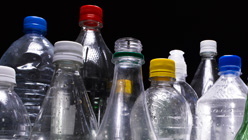In 2007, Oakland’s Beth Terry decided to give up plastic after seeing a picture of a dead seabird, its stomach filled with plastic bottle caps. Her decision spawned a blog, a book and a movement to make people aware of how much plastic they consume. We’ll talk to Terry about how, and why, people should reduce their plastic use, from changes obvious (carry your own reusable water bottle) to the surprising (kick that chewing gum habit).
12 Simple Ways to Reduce Your Plastic Footprint
Beth Terry says she doesn't hate plastic. She simply "hates what we do with it."
Those are about the kindest words Terry has about the petroleum-based product. She is the author of "Plastic Free: How I Kicked the Plastic Habit and How You Can Too," and the blog myplasticfreelife.com.
Terry's transformation to plastic-activist started when she saw a photograph of a dead sea-bird whose insides were filled with plastic objects like bottle caps, cigarette lighters — even a toothbrush. That photo launched Terry onto a singular mission — to cut down the amount of plastic in the world.
And while Terry is not alone — more than ever the public has taken a critical eye toward plastic — both for perceived negative effects on the environment and health – many of us carry a metal SIGG bottle with us, throw plastic containers into the recycling bin and call it a day.
Terry does much more and says that it's not that difficult for us to do more too. Here, gleaned from Terry's interview with guest host Scott Shafer on Forum are 12 straightforward ways to reduce the amount of plastic in your life.
1. Pay attention
Terry suggests before even trying to rid your life of plastic, simply take some time to become aware of how and when you use it. Here website has a "plastic challenge" that encourage people to track their plastic use for one week.
"It's amazing, the awareness that comes though doing the challenge, says Marianne Davis, who took Terry's challenge. " After completing in the challenge, Davis says "Whenever you touch plastic you kind of are, like "Wait a second, what do I about this? Do I really need this? Is there an alternative to this?"
2. When dining out, request drinks without plastic straws.
3. Buy milk in glass bottles.
Though many people don't associate milk cartons with plastic, they are actually lined with a plastic film. Terry says that pretty much any packaging that is leak-proof has plastic in it.
4. Give up chewing gum and hard candies.
Yes, chewing gum is plastic.
5. Buy in bulk and bring your own reusable food containers and bags to the store.
Terry and her husband bring a stainless steel bucket to the butcher counter and ask them butcher to put the meat in that instead of plastic-lined paper. She recommends frequenting the same businesses so that they grow accustomed to your request.
6. Use a tool lending library.
"If it's a tool that you're only going to use once, why buy a brand new one," says Terry. "Borrow it."
7. Shop secondhand and shop less overall.
When it comes to durable items like electronics and appliances, Terry asks herself "Do I really need something new?" If it turns out that she does need the item she finds "a way to get it so that I'm not creating more demand for new plastic in the world. I look for it secondhand or I borrow it, or rent it."
8. Bring own food containers to restaurants.
9. When you place an order, request that it be shipped without plastic packaging.
10: Send an email.
Contact your state legislators and let them know that you support AB 298 and SB 568. Contact your Senators and let them know that you support the Safe Chemicals Act, S. 847.
11. Don't use new plastic bags to pick up after your dogs.
Instead use newspapers, pages from an old telephone book or plastic bags that are already lying around your house.
12. Give feedback to companies.
When you find a product you want that's packaged in plastic, write a letter to the company asking if they'll switch the packaging.
And lastly, if you start to get frustrated, there's this last bit of advice:
13. Focus on can, not can't
"Focus on the areas where we're creating the most waste and have the most impact. Don't get hung up on if they're plenty of other things you can be doing."
In other words, don't lament the plastic in your contact lenses or prescription bottles if you still haven't changed the things you can more easily control.
Terry says it's important to smart small and "go at your own pace."
"It's important to take it step by step," says Terry. "I emphasize constantly: 'Choose one thing, make it a habit, do the next step, make it a habit."
The Forum Staff Takes the Plastic Challenge
To prepare for the discussion on plastics, the Forum staff decided to have some fun and take Beth Terry's challenge to track all of the plastic we used for one day. Our efforts are documented in the photos below.
Note: Your device must be Flash-enabled to view these items.
Did you take Beth Terry's challenge? You can share your photos on the KQED Flickr page.
Beth Terry's TED Talk
